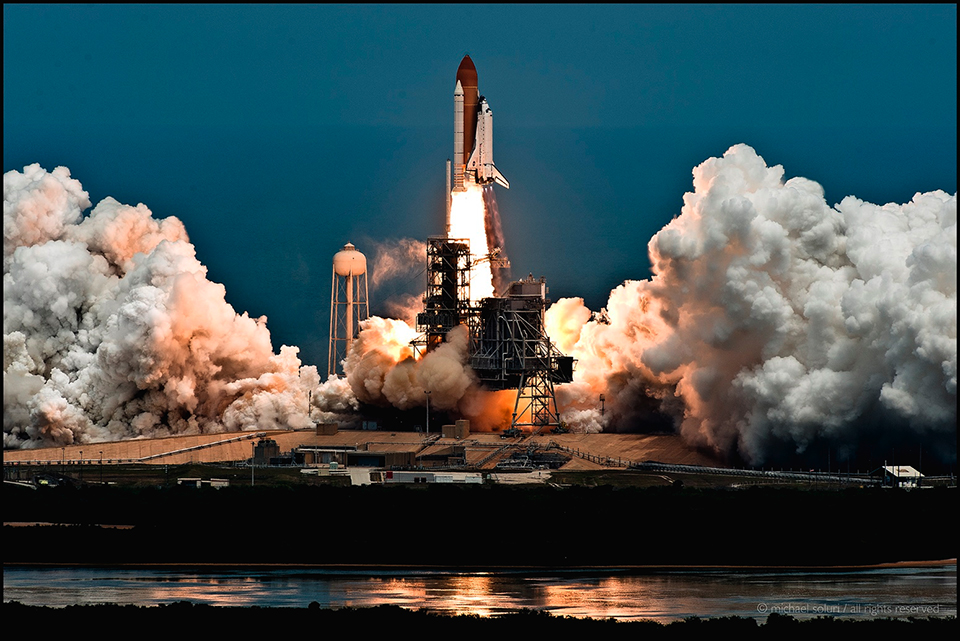Case Studies
Michael Soluri
Before I acquired my first EIZO monitor in early 2009, I had been using another manufacturer’s large screen display. When out on the road (for several years) documenting the last NASA shuttle mission to the Hubble Space Telescope — my “ah ha” moments were actually a series that revealed the instability of the previous monitor’s color balance and screen illumination consistency. Given this frustration, I clearly needed a significantly better monitor given the historical importance of my work.
When I acquired my first EIZO (CG222W) there was a progressive learning curve in acquiring proficiency. For example, once I set up the EIZO monitor I had to learn to color balance the monitor on a regular bases. As a result, the stability of the monitor allowed me to produce dramatically better, higher quality imagery.
|
However, by the fifth year and with a book deal from Simon & Schuster, I needed a larger stable monitor screen environment. When I acquired the EIZO ColorEdge CG277 in early 2014, the results were incredibly satisfying visually and technically. And it didn’t hurt that this monitor was self-calibrating. Amen!
In the months leading to Infinite World’s printing, I was on a series of dynamic deadlines with my publisher Simon & Schuster. Based on a significant number of paper and image file tests coordinated between their production manager and the pre-press team at RR Donnelly in Hong Kong, my goal was to submit the highest quality press-ready RGB files as accurately as possible for conversion to CYMK. In fact the print production manager commented that in his history of preparing photography related books, the publisher had never received as consistent level of press-ready images as the 340 files I had delivered. The result of this highly coordinated effort — heavily dependent on my EIZO CG277 — is a 348 –page, 4-color sheet fed coffee table book who’s technical and aesthetic quality is as good as a fine art book. |
|
Michael Soluri pictured with the ColorEdge CG277 (January 2016) |
In addition, EIZO provided me the means to create consistently accurate high-resolution print files that have been exhibited at museums in New York, Washington and the Kennedy Space Center.
About Michael Soluri
Michael Soluri is a New York City-based documentary photographer, speaker and the author of Infinite Worlds: the People and Places of Space Exploration (Simon & Schuster). Based on his three years of unprecedented access to the last shuttle based service mission to the Hubble Space Telescope, his photographs have been exhibited in “Outside the Spacecraft: 50 years of EVA” at the National Air & Space Museum, “Hubble@25,” the Intrepid Sea, Air and Space Museum in New York, and in the Space Shuttle Atlantis Pavilion at the Kennedy Space Center in Florida. Since 2005 he has been also documenting the people and places of the New Horizons mission to the Pluto System and Kuiper Belt. Images from that work have most recently appeared in print and online magazines like WIRED, Smithsonian, New Scientist, Huffington Post Highline, Ciel et Espace, and on the front page of the New York Times among others.
Soluri has appeared on MSNBC’s The Cycle, interviewed by Dr. David Livingston for the online radio Space Show, spoken at the Smithsonian Institute Hirsshorn Museum, the Chicago Museum of Science & Industry, the Denver Museum of Nature & Science Conversation, the National Air & Space Museum with astronaut John Grunsfeld, and with broadcast journalist Miles O’Brien at the Intrepid Sea, Air and Space Museum. His book, Infinite Worlds, has been cited in Quest Magazine, Air & Space, Discover, Spaceflight Insider, and Space Collect among others.

Launch of STS 125: the Space Shuttle Atlantis with a crew of seven headed for the last-ever servicing mission to the Hubble Space Telescope (May 2009)

On location portrait of astronaut K. Megan McArthur, Ph. D. Megan, the robotics engineer on the last shuttle mission to the NASA/ESA Hubble Space Telescope in 2009.

On-location portrait of astronaut John M Grunsfeld, Ph.D — now NASA associate administrator of the Science Mission Directorate (May 2009)

First reactions by some of the New Horizons mission science team as the first full frame image of the dwarf planet Pluto is revealed in the early morning of 14 July 2015.
Photo courtesy of Simon & Schuster
To see more of Michael’s work, please click the cover image above.




